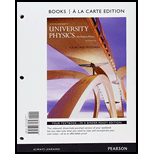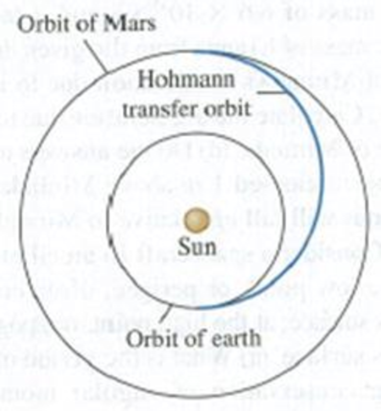
Concept explainers
Interplanetary Navigation. The most efficient way to send a spacecraft from the earth to another planet is to use a Hohmann transfer orbit (Fig. P13.79). If the orbits of the departure and destination planets are circular, the Hohmann transfer orbit is an elliptical orbit whose perihelion and aphelion are tangent to the orbits of the two planets. The rockets are fired briefly at the departure planet to put the spacecraft into the transfer orbit; the spacecraft then coasts until it reaches the destination planet. The rockets are then fired again to put the spacecraft into the same orbit about the sun as the destination planet. (a) For a flight from earth to Mars, in what direction must the rockets be fired at the earth and at Mars: in the direction of motion or opposite the direction of motion? What about for a flight from Mars to the earth? (b) How long does a one-way trip from the earth to Mars take, between the firings of the rockets? (c) To reach Mars from the earth, the launch must be timed so that Mars will be at the right spot when the spacecraft reaches Mars’s orbit around the sun. At launch, what must the angle between a sun-Mars line and a sun-earth line be? Use Appendix F.
Figure P13.79

Want to see the full answer?
Check out a sample textbook solution
Chapter 13 Solutions
University Physics with Modern Physics, Books a la Carte Plus Mastering Physics with eText -- Access Card Package (14th Edition)
Additional Science Textbook Solutions
Campbell Essential Biology with Physiology (5th Edition)
Organic Chemistry (8th Edition)
Campbell Biology (11th Edition)
Laboratory Experiments in Microbiology (12th Edition) (What's New in Microbiology)
Human Physiology: An Integrated Approach (8th Edition)
Human Anatomy & Physiology (2nd Edition)
- Three resistors R₁ = 88.1 Q, R2 = 19.9 £2, R3 = 70.00, and two batteries & ₁ = 40.0 V, and ε2 = 353 V are connected as shown in the diagram below. R₁ www E₁ E2 R₂ ww ww R3 (a) What current flows through R₁, R2, and R3? 11 = 0.454 Did you choose directions for each of the three currents? Given that you have three unknowns to solve for, how many equations, at the least, will you need? A 12 = 1.759 Did you choose directions for each of the three currents? Given that you have three unknowns to solve for, how many equations, at the least, will you need? A 13 2.213 = Did you choose directions for each of the three currents? Given that you have three unknowns to solve for, how many equations, at the least, will you need? A (b) What is the absolute value of the potential difference across R1, R2, and R3? |AVR1 = 40.0 How is the potential difference related to the current and the resistance? V |AVR2 = 35.0 How is the potential difference related to the current and the resistance? V |AVR3 =…arrow_forwardIn the attached image is the circuit for what the net resistance of the circuit connected to the battery? Each resistance in the circuit is equal to 14.00 kΩ. Thanks.arrow_forwardDetermine the equivalent capacitance for the group of capacitors in the drawing. Assume that all capacitors be the same where C = 24.0 µF. Thank you.arrow_forward
- In the figure below, what is the net resistance of the circuit connected to the battery? Assume that all resistances in the circuit is equal to 14.00 kΩ. Thank you.arrow_forwardDue to the nature of this problem, do not use rounded intermediate values-including answers submitted in WebAssign-in your calculations. 3 4 Find the currents flowing in the circuit in the figure below. (Assume the resistances are R₁ =6, R₂ = 20, R₂ = 10 N, R₁ = 8, r₁ = 0.75 0, r2=0.50, 3 × A × A I, = 3.78 12 13 = 2.28 = 1.5 × A R₁ b a R₁₂ w C 1, 12 13 R₂ E3 12 V E₁ 18 V g Ez 3.0 V 12 Ea شرة R₁ e 24 V d = 0.25 0, and 4 = 0.5 0.)arrow_forwardIn the circuit shown below Ɛ = 66.0 V, R5 = 4.00 £2, R3 = 2.00 N, R₂ = 2.20 N, I5 = 11.41 A, I = 10.17 A, and d I₁ = 6.88 A. Find the current through R2 and R3, and the values of the resistors R₁ and R. (Due to the nature of this problem, do not use rounded intermediate values—including answers submitted in WebAssign-in your calculations.) 12 = 8.12 A RA = -1.24 Based on the known variables, which two junctions should you consider to find the current I3? A 9.59 Which loop will give you an equation with just R₁ as the unknown? Did you follow the sign convention for the potential difference across each element in the loop? 6.49 Which loop will give you an equation with just R as the unknown? Did you follow the sign convention for the potential difference across each element in the loop? N R₁ ww R₂ www R4 ww 14 15 www R5 www R3arrow_forward
- Certain types of particle detectors can be used to reconstruct the tracks left by unstable, fast-moving sub-atomic particles. Assume that a track with a length of L=2.97 mm in the laboratory frame of reference has been observed. Further assume that you determined from other detector data that the particle moved at a speed of L=0.910 ⚫ c, also in the laboratory frame of reference. c denotes the speed of light in vacuum. What proper lifetime would you determine for this particle from the data given? T= 4.0 Sarrow_forwardgenerated worksheetarrow_forwardWhile cruising down University Boulevard you are stopped by a cop who states that you ran a red traffic light. Because you don't want to pay the stiff fine, you are attempting a physics defense. You claim that due to the relativistic Doppler effect, the red color of the light λ=616 nm appeared green '=531 nm to you. The cop makes a quick calculation of his own and rejects your defense. How fast, in terms of your speed u divided by the speed of light in vacuum c, would you have to drive to justify your claim? Note that the speed u is taken to be a positive quantity. U 4.0 Carrow_forward
- 220 V is supplied to 800 primary turns of an autotransformer. What will the outputvoltage be across 200 secondary turns? 2. A filament transformer has a turns ratio of 1:20. What current must be supplied to theprimary windings if 5 A is required by the filament? 3. The filament transformer in the previous question is supplied with 150 V to theprimary side. What is the secondary voltage? 4. 440 V is supplied to 1000 primary turns of an autotransformer. If the desired outputvoltage is 100 V how many secondary turns must be tapped?arrow_forward220 volts is supplied across 1200 winding of the primary coil of the autotransformer.If 1650 windings are tapped, what voltage will be supplied to the primary coil of thehigh-voltage transformer?2. A kVp meter reads 86 kVp and the turns ratio of the high-voltage step-up transformeris 1200. What is the true voltage across the meter?3. The supply voltage from the autotransformer to the filament transformer is 60 volts. If theturns ratio of the filament transformer is 1/12, what is the filament voltage?4. If the current in the primary side of the filament transformer in question 3 were 0.5 A,what would be the filament current?5. The supply to a high-voltage step-up transformer with a turns ratio of 550 is 190 volts.What is the voltage across the x-ray tube?arrow_forward220 V is supplied to 800 primary turns of an autotransformer. What will the outputvoltage be across 200 secondary turns? 2. A filament transformer has a turns ratio of 1:20. What current must be supplied to theprimary windings if 5 A is required by the filament? 3. The filament transformer in the previous question is supplied with 150 V to theprimary side. What is the secondary voltage? 4. 440 V is supplied to 1000 primary turns of an autotransformer. If the desired outputvoltage is 100 V how many secondary turns must be tapped?arrow_forward
 Principles of Physics: A Calculus-Based TextPhysicsISBN:9781133104261Author:Raymond A. Serway, John W. JewettPublisher:Cengage Learning
Principles of Physics: A Calculus-Based TextPhysicsISBN:9781133104261Author:Raymond A. Serway, John W. JewettPublisher:Cengage Learning Physics for Scientists and Engineers: Foundations...PhysicsISBN:9781133939146Author:Katz, Debora M.Publisher:Cengage Learning
Physics for Scientists and Engineers: Foundations...PhysicsISBN:9781133939146Author:Katz, Debora M.Publisher:Cengage Learning University Physics Volume 1PhysicsISBN:9781938168277Author:William Moebs, Samuel J. Ling, Jeff SannyPublisher:OpenStax - Rice University
University Physics Volume 1PhysicsISBN:9781938168277Author:William Moebs, Samuel J. Ling, Jeff SannyPublisher:OpenStax - Rice University Physics for Scientists and Engineers, Technology ...PhysicsISBN:9781305116399Author:Raymond A. Serway, John W. JewettPublisher:Cengage Learning
Physics for Scientists and Engineers, Technology ...PhysicsISBN:9781305116399Author:Raymond A. Serway, John W. JewettPublisher:Cengage Learning Physics for Scientists and EngineersPhysicsISBN:9781337553278Author:Raymond A. Serway, John W. JewettPublisher:Cengage Learning
Physics for Scientists and EngineersPhysicsISBN:9781337553278Author:Raymond A. Serway, John W. JewettPublisher:Cengage Learning Physics for Scientists and Engineers with Modern ...PhysicsISBN:9781337553292Author:Raymond A. Serway, John W. JewettPublisher:Cengage Learning
Physics for Scientists and Engineers with Modern ...PhysicsISBN:9781337553292Author:Raymond A. Serway, John W. JewettPublisher:Cengage Learning





